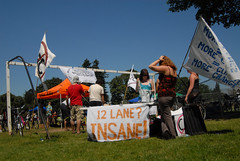
why they want to stop a
12-lane I-5 bridge.
(Photos © J. Maus)
Columbia River Crossing (CRC) project watchers are buzzing after a front page story in The Oregonian yesterday detailed its planning costs.
According to reporter Dylan Rivera, the planning effort for the new I-5 bridge has cost taxpayers $65 million. Here’s more from his opening paragraph:
“A new Interstate 5 bridge over the Columbia River has so far cost taxpayers $65 million, without a spade of dirt turned. By this time next year, the tab will hit $100 million — burning though cash at a rate of more than $1 million a month.
The result: mainly an environmental impact statement and thousands of pages of reports.”
The costs, writes Rivera, go partly to pay the 65 consultants working on the project and to fly in specialists from Florida and San Francisco.
For perspective, PBOT estimates they’ve spent about $60 million (total) to build our entire, existing bicycle network that includes over 370 miles of bikeways and is the envy of many major U.S. cities.
Rivera goes on to detail how many of the major decisions about the project remain at “square one” and how some members of Congress are critical of the project’s cost and scope. Rivera also points out that DOT officials and CRC consultants still maintain all is well with the project, citing normal complexities that arise in projects of this size.
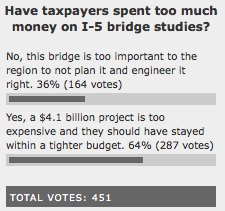
The Oregonian story comes off as bad publicity for the CRC at a time when politicians have to be very careful about supporting funding for big, controversial projects. The O story also has a poll, where a majority of respondents (64% of 451 votes so far) say the project is “too expensive”.
Meanwhile, a grassroots campaign in opposition to the CRC’s preferred “12-lane” solution is maturing. The group, a coalition that includes Rising Tide Cascadia, has a new website at StopTheCRC.org and has been tabling at local events. They join the existing Smarter Bridge Coalition in trying to raise attention to different alternatives to improving the I-5 crossing.
At the recent Sunday Parkways Northeast event, Stop the CRC activists and the paid CRC consultants had booths within a stone’s throw of each other. It made for some interesting conversations and visual juxtapositions:

were not shy about where they flew their flag.
With the high price tag of the CRC coming into center focus, talks about tolling have ramped up. The CRC website is now hosting a Tolling Study to garner feedback on the various tolling scenarios. The Portland Mercury wrote about tolls in its July 9th issue, and reporter Sarah Mirk wrote in a blog post that Metro Council President David Bragdon recalled, during a recent trip to DC, that U.S. DOT Secretary Ray LaHood said the project would be paid with tolls.
[On a sort of related note, Bragdon’s term is coming to an end and it’s been reported that in the race to replace him will be Bob Stacey and Rex Burkholder. Stacey is the director of land-use planning non-profit 1000 Friends of Oregon and has been staunchly opposed to the CRC project. Burkholder is a current Metro Commissioner who is known for his support of bikes and progressive planning visions, but who has also supported the CRC project (to the chagrin of some of his environmental-minded constituents).]
On the bike and pedestrian side of things, the CRC’s official bike and ped advisory committee is hammering out details of a security and maintenance agreement to go with what we’ve reported looks to be the front-runner design at the moment — a stacked bridge with a bikeway/walkway underneath. We’ll have a separate story more details on that agreement soon.
— StoptheCRC.org
— ColumbiaRiverCrossing.org
— The Smarter Bridge Blog


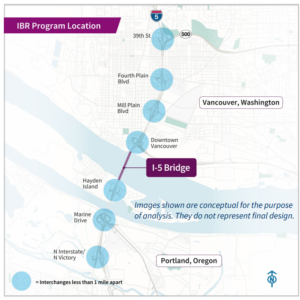
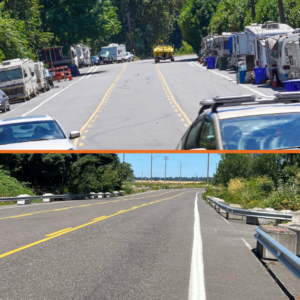
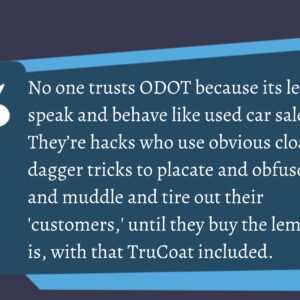

Thanks for reading.
BikePortland has served this community with independent community journalism since 2005. We rely on subscriptions from readers like you to survive. Your financial support is vital in keeping this valuable resource alive and well.
Please subscribe today to strengthen and expand our work.
Jonathan, small quibble: I would avoid referencing those online polls altogether, even if it does support a particular point of view. As I’m sure you are aware, polls of that variety are not intended to be objective and may or may not provide an accurate snapshot of public opinion.
andy,
you’re preaching to the choir. I understand your point about polls completely. I featured the one from The O simply to point it out to folks. As polls go however, i think that one was pretty well worded. It also has a bit more credibility than many other polls we see because it accompanies what I think comes off as a balanced story (therefore it doesn’t attract as many haters as something that asks, for instance, “Should cyclists pay taxes?”).
I hear you and thanks for the feedback.
Failure to oppose the CRC should be what voters use to eject weasels out of politics and business in Portland. The 12 lane I5 that follows will turn Portland into Houston.
This voter scrutiny includes the BTA, who has mentioned CRC just once in the last year of BTA digest newsletters. They might be against CRC, but they are not motivating their thousands of members to get involved in stopping the CRC.
Like Abortion, it is not a one issue vote. It is the canary in the mine. Someone who opposes the CRC is also someone who best represents the path Portland has made the last 10 years.
Someone who is not actively and publicly fighting the CRC can’t be trusted. They will bargain away anything under the name of being smart. They will take the wrong path to save their backyard.
I second #3. Bob Stacey is the only choice to run Metro thanks to Burkholder’s unconscionable decision to continue increasing GHG emissions in the transportation sector.
CRC SUX!
In a time when serious print journalism too often seems to be fading, Mr. Rivera has been doing the public a considerable service. Hats off.
It’s also worth noting that the environmental impact statement (EIS) that the CRC task force produced is a joke, as indicated by the U.S. Environmental Protection Agency. For one thing, the statement made the assumption that doubling the size of the bridge would have no effect on regional development patterns.
A correction: Bob Stacey is currently still the director of 1000 Friends of Oregon, although a search is underway for his successor. (Full disclosure: the organization has been my employer in the past.)
Public transportation is not always a viable option for the thousands of commuters from Vancouver into Portland every day. Perhaps Vancouver residents would be more open to tolls if there was a “non-resident income tax” for WA residents who work in Oregon. Currently, we pay the full Oregon income tax rate without the full benefit of the tax.
Re comment #3: I believe the intent of your comment is to cajole more support for your cause and get BTA to take a firmer stand against the CRC. Admirable, but then you veer off into this comment:
“Like Abortion, it is not a one issue vote. It is the canary in the mine. Someone who opposes the CRC is also someone who best represents the path Portland has made the last 10 years.”
As someone who is anti-CRC, pro-environmental and pro-life, I see this comment as un-necessarily making the anti-CRC movement smaller than it needs to be. Opposition to CRC needs to be as “big tent” as possible. Why make comments like this that only hurt the cause and fracture the movement? Am I welcome to join your cause or not? Is there some connection unbeknown to me between abortion and the CRC or are there implicit assumptions being made about who would be opposed or in support of such a cause?
They still haven’t convinced me they need to replace the bridge at all. It’s not near the end of its design life. It’s structurally sound. No one has performed a site-specific geotechnical engineering investigation (surprisingly, after spending all that money) so as far as we know there’s no soil-related seismic risk. Both the traffic safety issues and congestion are DIRECTLY attributable to TRAFFIC VOLUME. People shouldn’t be abusing the privilege of having a bridge — frivolosly deciding to live in Vancouver and work in Portland or vice versa. If you are driving back and forth over that bridge every day, you’re abusing it. Impose a toll, $200/month or $10 per one-time use, and be done with it. Let the car-dependent crybabies rot in Vancouver, move to where they work, or pony up the cash for a scarce resource (namely space on the I-5 and the bridge). It’s time.
I wanted to second andy at #1; webpolls are incredibly trite and irrelevant.
I also wanted to say that I really appreciate the fact that a blog like bikeportland has, like the urban cycling movement has begun to do itself, taken charge of a livable streets movement and is boldly critiquing both the CRC and the highway-industrial complex. As much as I love reading bikeportland’s articles on everything from bike fashion to bike events and local bike lanes, it’s going to be ever critical in an age of declining journalism for concerned citizens to use websites such as bikeportland to organize and spread information that goes counter to whatever $100m worth of ODOT consultants tell us about the necessity of this monstrous project.
They still haven’t convinced me they need to replace the bridge at all.
Really? Have you ever had the displeasure of having to actually cross that bridge between 4pm and 7pm on any given week night? Every single day my Google traffic widget shows a black and red line leaving downtown Portland going north to the river (which means it’s a parking lot). It’s a terrible design. I don’t know if 12 lanes is the answer, but I have yet to see any reliable data on exactly why the number 12 is such a terrible number of lanes. Maybe it is, but right now the opposition effort is 100% emotion and 0% research. I can respect good research, and think of me as a constituent who is totally open to opposing this bridge if I can be shown that it is actually as terrible as it is being made out to be.
I also know that the current bridge needs to be replaced. It’s beyond terrible. I am totally behind a toll for this bridge as well. I can’t understand, though, why a 10 lane toll bridge is ok, or an 8 lane bridge. Portland is currently growing at 4 times the average US city, and smart urban thinking often means planning ahead for the future, and not just dealing with current needs. For a ‘world class city’ like Portland, there is no excuse for the current juggernaut of the current 1-5 bridge. Having a permanent parking lot is not good urban planning, whether you ride a bike, bus, or car.
Look at all the brand name players who say they oppose the CRC and you don’t see much activism. If the BTA, CLF, Alta Planning, etc were to suddenly use their resources to get voters or members to rise up, meet, or dialog with each other, their paychecks and bike projects would suffer.
The Anti-CRC tent can be big, but it’s clear that those with bias are trying to subdue the content of messages in the tent, and what comes out.
At the NE Parkways ride the Pro-CRC tent had Peter Ovington being paid by taxpayers like me. He is with the consulting firm enviroissues.com who was billing the state for his work doing “community Involvement” and selling the bridge to the thousands of cyclists that Sunday.
Connect the ugly dots, big picture. It’s not what people say, it’s what they do, and duties they avoid.
KruckyBoy,
If you check with the CRC you’ll find that the $4.2billion replacement bridge ends up a parking lot a few years after it’s completion.
Go back in time a bit and you’ll find the I205 bridge was built to end I5 congestion. Go back alittle further and you find the same reasoning for second of the twin Interstate Bridges.
You cannot build your way out the traffic jam.
The Interstate bridges are structurally sound and do not need to be demolished.
I’d quibble with the term “weasel”, but otherwise Joe (#3) is spot on in his first 2 paragraphs – and not just in Portland, you Vancouverites (and the burbs – Washougal, Woodland, etc) should take note as well and send a message home to your politicians. CRC will *increase* congestion, not decrease it, and it will move the backups further south into Portland and further north into Vancouver and clog every on and off-ramp in that corridor, and their immediately adjacent intersections.
I lived in Detroit for 22 years, I’ve seen the results of “build it and they will come” firsthand. CRC is misguided and dangerous, and thankfully the poor economy is making the project politically dubious. let’s all keep the pressure on and remember to ask everyone involved, “how are you going to pay for this?”, “What happens if the project runs out of money?”, and “Is $4.2 billion really necessary when vehicle miles traveled (VMT) is decreasing?”.
The BTA needs to take a stronger stand against the 12-lane CRC. Scott Bricker, you have a chance to be the vanguard – take it! The same goes for Metro (regardless of who is involved – let’s not single out Rex, there are 7 metro councilors).
CRC is the Mount Hood Freeway of our era. We have the opportunity to be the leading, visionary region of Oregon and the nation, as we have in the past, or we can make the same decisions that cities like Phoenix, Detroit, Atlanta and Dallas-Fort Worth have made – decisions which have reduced quality of life, impacted public health and safety, and made the roads more dangerous and less pleasant.
KruckyBoy (#9) – respectfully, if you can’t see any hard data on why 12 lanes is bad, you’re not looking very hard. I don’t have time to find case studies at the moment – hopefully someone will dredge some up, but take a look at DC’s Beltway, or more to the point, any of the freeways in metropolitan Detroit which have been widened in the last 2 decades. Regional growth has been low, and central city “growth” has been negative, yet all of the projects have increased congestion and increased VMT.
—
CRC needs to be stopped, or at least curtailed. $4.2 billion is more than we can afford, to give us capacity we don’t need.
I wake up every morning to OPB telling us that the traffic problem on I-5 southbound begins at Delta Park – not the I-5 bridge. One-half of the $4B price tag is to build more lanes and on-ramps leading to the freeway — mostly in Vancouver. No-one has ever said that any structural problems with the current bridges can’t be repaired for about 1/20 the cost of the CRC. And re have a commenter whining about his daily rush hour commute across the bridge – so we as a region should spend billions to change a road system he knew about when he moved to Vancouver or started working in Portland.
And to blame the BTA for this is utter nonsense. The BTA was threading a small political needle this past legislative session working on a number of issues, and the CRC is pushing, or clearly outside, the bounds of the BTA mission.
The CRC seems much more of a WSDOT dream project than anything else. Freight and lightrail are the excuses being used to get Portland to accept the monster project… when it seems that the $1B for Vancouver light rail and congestion tolling would get us at least part of the way to solving the traffic problems. The other $3B for the project is to facilitate car commuting from and sprawl in Vancouver and the rest of Clark County.
Wonderful to see this still getting the headlines for its cost issues. Good work tabling at parkways! Everyone against the scope and cost of this megabridge can and should do more. I will dive back into the fight when I return from travel and bike/journalism assignments in California and Africa.
See you at August Sunday Parkways.
Gov. Gregoire may have shot the whole thing in the head yesterday when she pretty much stated “no tolls, no new bridge.” Hell will freeze about a week before many Clark County residents support tolls on the bridge.
The CRC is just a way to steal our money. They have nothing but cheap slogans to push down our throats.
Obviously, since the project is preposterous, money is already being spent (and made) during this so-called planning. I thought the article would actually show where the money was going to, but that’s not very clear. I would bet $4.2 bi that at least $15 mi has been spent with lobbying, which is the new face of democracy.
Keep the current bridge and add a second lightrail/bike/ped bridge.
It really is that simple.
I’m starting to come around on a bridge design that would simply cantilever the existing span for improved bicycle / pedestrian facilities and just be done with it. Everyone’s whining about tolls, or sprawl, or poor-mouthing, and this project just doesn’t seem to have the momentum.
The problem is the CRC, if approved, won’t happen for another fifteen years or so. I’d rather see common sense solutions now, and I don’t mean a third bridge like so many in Clark County are feverishly hoping for.
if the infrastructure is inevitable, I guess I am willing to pay for it, but at least let’s repeal 814.420.
The big, bloated CRC seems destined for failure, and while I find it’s tempting to stand back and watch it sink under the weight of its own massive expense, it’s better, I think, to do everything possible to help it hurry up and fail. Any victory at all against a project like this would be a boost for everyone working against the insanity of this kind of development, which seems to operate on the assumption that there can be infinite expansion in a finite world.
The creation of I-5 in the post WWII years decimated neighborhoods along its alignment. Only recently has economic benefit come to those neighborhoods.
A creation of a 3rd bridge would create a new roadway alignment to service it, and more neighborhoods would divided and destroyed as a result. At the same time, Metro projects another million people in the metro area in the next 20 years.( perhaps recent economic climate might change this projection). With all these new people, material movement to support living and the economy will significantly increase.
These are some of the drivers for building this new bridge. Knowing full well it will take 10 years from the time the bridge is approved to ribbon cutting , operating on todays realities might be shortsighted thinking.
Again, tolling and introduction of light rail to Vancouver by the yellow and red lines would have some impact. Forget servicing Clark Co. as they are firmly entrenched in the single car mode. Foisting increased transit on them at this time would be wasted effort.
If I am all over the place with my thoughts on the building a new CRC model bridge,its because there is a fair amount of crystal ball gazing going on. What will our needs be in 15 years? can we afford to build this megabridge? What would happen if we didn’t? Would economic incentive be sufficient to dissuade those single car trips to seriously be reduced? IS this bridge even needed?
Even if by todays needs that CRC is not needed, do we build for the future or play catch up when the need really is there?
CRC is not needed. The talks about “building it for the future” assume that there is an inevitable, already written future that we need to be ready for, rather than understanding that our actions today will help shape the kind of future we will have.
So, yes, this new bridge or expansion will be needed if that’s what we want – to turn our city on freeways.
But if we are honest about where we are today and where we come from, we’ll see that there’s a lot of work to be done, if we are to survive – socially (versus destroying communities), economically (versus supporting oligarchic policy-making interests) and well, naturally (rather than destroying our habitats).
Those trying to make us swallow this load of crap are criminals. They are taking our money, while diverging very important attention from real development.
A lot of people are spreading the myth that the CRC project is a sinking titanic. ( sorry for the cliche )
Myth or not, the sinking ship needs to be hauled way out to sea and torpedoed, and ( figuratively ) with it all the people and methods of promoting and subsidizing Single Occupancy Vehicles at commute times.
Let’s face it, the HOGS in their SOVs are what is blocking the trucks and other transit in PDX. At 5pm the Northbound HOV lane at Rosa Parks way is often full but going 40mph, and the SOV traffic is 5mph.
All emotion and no data? Not. Find me one freeway expansion that 10 years later is not stalled at rush hour in the USA. Chicago(355), Phoenix and Houston(8) are prime examples, no matter how many lanes and beltways you build, the bottlenecks keep happening.
San Francisco is one of the few cities to halt the Federal interstate build up. Feds tried to put in the Embarcadero Freeway, connecting HWY 101 to I-80. Somehow the sky did not fall from 1960-1989. Then an earthquake shocked everyone even more, the voters approved 4 times, measures to remove remaining damaged ramps and central freeway. CALTRANS and car lobbies tried 4 times to kill the will of the voters. The zombies that would not die, finally lost.
Part of the use of on and off ramps near the Columbia is to access a nearly dead mall area. How much would it cost to pension off about half of the merchants and workers at Jantzen Beach, which for at least ten years has had conspicuous empty spots? One of the few genuine functional flaws in the current bridge area are the 1958-designed ramps–they have been inadequate for many years in particular the ramp to I-5 North which causes motorists to come to a near stop immediately before entering the freeway.
Tear down the empty Thunderbird Hotel, eminent-domain it into greenspace, in short remove purposes for people to use cars in that area. Diminished retail space at Jantzen might cause some Vancouver shoppers to (shudder!) shop in Vancouver, even. I see wins in every direction here.
Waaa…Waaaah…Cry me a river… Vancouverites want everything for nothing… They want an Oregonian’s job but don’t want to pay the state income tax an employed Oregonian would have paid.
Then they want to live the cheaper but more wasteful lifestyle of the suburbanite but cry that, poor me…we don’t have public transportation… “waaah…waaah…we voted down light rail years ago…waaah…waaah…I don’t want to pay tolls…waaah!”
As ususal, they want those of us who love Oregon enough to acutually live here, to pay their way. We already pay for higher property taxes, the higher costs of schooling urban children and then compete with them for jobs in our own state — AND they still want us to pay their way.
Sorry, tasteless cheapskates, you CAN’T have it all.
#25 Stochelo
Excellent point. I think this aspect of the congestion problem doesn’t get nearly enough attention.
It’s interesting to look at Google Map’s traffic congestion feature. It shows red lines for stopped traffic, yellow for slow, green for freely moving traffic. It also has a feature that shows the average congestion for a given day and time. I played with it a bit and noticed that around the crossing there was definitely a big red traffic jam coming from Vancouver in the morning – obviously a bit corked at the bridge – but the traffic jam returning to Vancouver in the evening was something like double the size. Suggesting the possibility that it was turbulence from the Hayden Island ramps that was a big part of the problem. Because people will be trying to hit those stores in the evening, and then diving back onto the freeway, slowing things down. Much more than they would be at eight in the morning.
What could possibly be a worse location for a big-box shopping center?
its great to hear so many people feel like i do. If we each choose one person to talk to about this topic every day we can really get it changed for the better.
If we use the time while riding the bus, waiting in line at a show, or in between any other 100 daily activities we have we can find someone. We dont even have to convince them about our opinions, but if we get people thinking about it, these truths will be apparent to just about anyone.
Lots of relevant info at:
http://SmarterBridge.blogspot.com